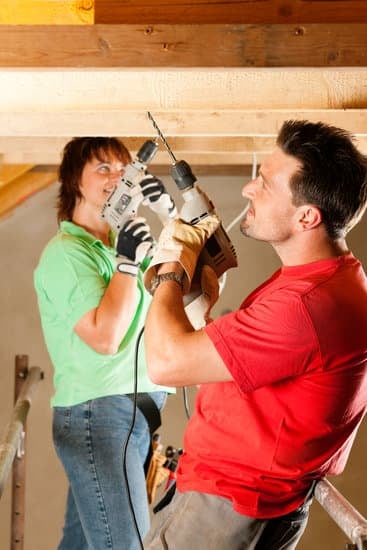Are home office improvements tax deductible? Understanding the tax implications of home office improvements is crucial for homeowners and small business owners alike. From defining what qualifies as a home office improvement to navigating the complexities of claiming deductions, it is essential to have a comprehensive understanding of the topic.
This article aims to provide clarity on the tax deductibility of home office improvements, outlining what qualifies, eligibility criteria, how to claim deductions, potential tax benefits, and common misconceptions. With the proper knowledge and record-keeping, individuals can make informed decisions when it comes to improving their home office space.
Home office improvements encompass a wide range of renovation projects that are aimed at creating a conducive workspace within a residential property. This may include anything from adding built-in shelving and cabinetry to installing dedicated lighting or upgrading technological infrastructure. It is imperative for homeowners and small business owners to comprehend what qualifies as a home office improvement and the significance of keeping detailed receipts and documentation for these expenditures.
Understanding tax deductions for home office improvements is essential for maximizing potential savings while complying with IRS regulations. By acquainting oneself with eligibility criteria, limitations, and restrictions on deductions, individuals can make informed decisions regarding their renovations. Seeking professional advice can be beneficial in navigating through the intricacies of tax implications related to home office improvements and avoiding any potential penalties for non-compliance due to misunderstandings or misconceptions.
What Qualifies as a Home Office Improvement
Definition of Home Office Improvement
A home office improvement is any renovation or modification made to an area of your home that is used for business purposes. This can include changes to the physical structure, such as adding a separate entrance or building an addition, as well as improvements to the interior space, like installing built-in shelves or upgrading the lighting and electrical systems.
Examples of Qualifying Improvements
Some common examples of home office improvements that may qualify for tax deductions include painting, replacing flooring, installing built-in furniture or cabinetry, adding insulation, and making modifications to improve accessibility. It’s important to note that not all home office improvements are eligible for tax deductions, so it’s crucial to understand which expenses can be claimed.
Importance of Keeping Receipts and Documentation
To claim tax deductions for home office improvements, it is essential to keep detailed records and receipts for all related expenses. This includes invoices from contractors and suppliers, permits and approvals from local authorities, and any other documentation that demonstrates the costs incurred for the improvement. These records will be crucial in proving the eligibility of the expenses claimed during a tax audit or review by the IRS.
Home Office Improvement Tax Deductions
Home office improvements can make a significant difference in the functionality and aesthetics of your workspace. But did you know that some of these improvements may also be tax deductible? Understanding the potential tax implications of home office improvements is crucial for taxpayers who operate their business from home. It is important to determine which expenses qualify for deductions, as well as the limitations and restrictions that come with claiming these deductions.
Qualifying as a home office improvement is determined by whether the improvement adds value to your home office space or prolongs its useful life. Some examples of qualifying improvements include adding new fixtures or built-in storage, installing upgraded lighting, or making structural changes such as adding walls or expanding the office space.
It’s crucial to keep detailed receipts and documentation for all improvement expenses, as these will be necessary when it comes time to claim deductions on your taxes.
When it comes to claiming deductions for home office improvements, taxpayers must meet certain eligibility criteria set by the IRS. Generally, the improvements must be directly related to your business operations and used regularly and exclusively for work purposes.
There are limitations and restrictions on what can be claimed as a deduction, so it’s important to understand these regulations before attempting to claim any expenses. Additionally, if the improvement benefits both your personal and professional use of the space, only the portion used for business is eligible for deduction.
At first glance, navigating the world of tax-deductible home office improvements may seem overwhelming. However, with proper guidance and understanding of IRS guidelines, taxpayers can effectively maximize their deductions while complying with regulations set forth by federal tax law. Whether it’s through seeking professional advice or familiarizing oneself with necessary forms and documents, taking proactive steps in this area can lead to potential tax benefits in future filings.
How to Claim Home Office Improvement Deductions
A home office can be a great benefit for many individuals, providing a dedicated space for work and productivity. However, the costs of setting up and maintaining a home office can quickly add up. That’s why it’s important to understand if and how you can claim tax deductions for home office improvements.
So, are home office improvements tax deductible? The simple answer is yes, but there are specific criteria that must be met in order to qualify for these deductions.
When it comes to claiming tax deductions for home office improvements, it’s important to understand what qualifies as an improvement in the eyes of the IRS. Generally, a home office improvement is defined as any expense that adds value to your home or prolongs its useful life.
This could include renovations such as adding built-in shelving, installing new carpeting, or upgrading lighting fixtures. It’s important to keep detailed receipts and documentation for all improvements made to your home office in order to accurately claim these deductions.
In order to claim tax deductions for home office improvements, you must meet certain eligibility criteria set by the IRS. These criteria typically require that your home office is used regularly and exclusively for business purposes.
Additionally, the space you are claiming as a home office must be your principal place of business or used on a regular basis for meeting with clients, customers, or patients. It’s important to note that there may be limitations and restrictions on the amount you can deduct for these improvements, so it’s crucial to familiarize yourself with the relevant IRS guidelines.
| Home Office Improvement Criteria | Description |
|---|---|
| Regular and Exclusive Use | The space must be used solely and regularly as your principal place of business |
| Business Use Requirement | The space should be used primarily for conducting business activities |
| Receipts and Documentation | All expenses related to home office improvements should be properly documented with receipts |
Tax Implications of Home Office Improvements
Impact on Future Tax Filings
When considering home office improvements, it’s essential to understand the impact they can have on future tax filings. Some improvements may qualify for tax deductions, but they can also affect your property taxes when it comes time to sell your home. For example, if you convert a portion of your home into a dedicated office space, you may be able to deduct a percentage of your mortgage interest or utility bills.
However, when you sell your home, the IRS may consider that portion of your property as business property, subject to different tax rules. It’s important to consider these long-term implications before making any significant home office improvements.
Potential Tax Benefits of Improvements
While certain home office improvements may not be fully deductible right away, they can still provide potential tax benefits in the long run. For example, if you make structural changes to your home to create a separate office space such as adding a wall or installing built-in shelving, these expenses may not be fully deductible in the current year.
However, they can increase the basis of your home, which affects the amount of profit (if any) that is subject to capital gains tax when you sell your house. Understanding how improvements can impact the value of your home and potential tax benefits is crucial for making informed decisions.
Considerations for Depreciation and Asset Value
Another important aspect to consider when it comes to the tax implications of home office improvements is depreciation and asset value. Certain improvements that are directly related to your business use-such as equipment or furniture-may qualify for depreciation deductions over time.
It’s important to keep accurate records and consult with a tax professional to ensure compliance with IRS guidelines and maximize potential deductions. Additionally, understanding how these improvements affect the overall value of your assets is crucial for accurate financial reporting and future tax planning.
By taking into account these potential tax implications of home office improvements, individuals can make informed decisions and better position themselves for future tax filings while complying with IRS regulations.
Common Misconceptions About Home Office Improvements and Tax Deductions
Many individuals mistakenly believe that all home office improvements are automatically tax deductible. However, it’s important to understand that not all improvements made to a home office will qualify for tax deductions.
It is crucial to distinguish between regular home maintenance and improvements specifically related to the home office. In order to avoid confusion and potential tax issues, it is advisable to consult with a tax professional or accountant who can provide guidance on what may or may not be eligible for deductions.
One common misconception is that any improvement made to a home office, regardless of its purpose or impact on productivity, can be deducted from taxes. In reality, only improvements directly related to the functioning and productivity of the home office space are eligible for tax deductions.
Examples of qualifying improvements include adding built-in shelving, installing insulation for soundproofing, or renovating the space to create dedicated work areas. It’s also important to keep detailed receipts and documentation for all improvements in order to support any deductions claimed.
Another misconception is that home office improvement tax deductions are limitless. While there are potential tax benefits available, there are limitations and restrictions on what can be claimed as deductions. Understanding the eligibility criteria for claiming these deductions is essential in order to avoid any discrepancies with the IRS. Eligible expenses must be directly related to the home office and used exclusively for business purposes in order to qualify for deductions.
Furthermore, many people assume that they can make substantial improvements to their home office space and immediately claim them as tax deductions without considering potential future implications. It’s important to understand the long-term tax implications of these improvements, including depreciation and changes in asset value. Seeking professional advice regarding the potential benefits and drawbacks of making substantial investments in a home office space is essential for making informed decisions about renovations and upgrades.
Importance of Compliance and Record Keeping
Home office improvements can be a significant investment, but the good news is that they can often be partially tax deductible. However, it is crucial to understand the importance of compliance and record-keeping when it comes to claiming these deductions. The Internal Revenue Service (IRS) has specific guidelines and requirements that must be followed in order to claim deductions for home office improvements. Failure to comply with these guidelines can result in penalties and complications during tax filings.
When it comes to claiming tax deductions for home office improvements, accuracy and thorough record-keeping are key. It is essential to keep detailed records of all expenses related to the improvement, including receipts, invoices, and any contracts with contractors or service providers. This documentation will be necessary when filing taxes to support your claims for deductions, especially if you are audited by the IRS.
Failure to maintain accurate records or comply with IRS guidelines can lead to serious consequences. Penalties for non-compliance may include fines, interest on unpaid taxes, and even legal action in cases of tax fraud or evasion. Therefore, it is imperative for individuals who are considering claiming home office improvement deductions to prioritize compliance and record-keeping from the outset of their improvement projects.
In order to ensure compliance and proper record-keeping, homeowners should seek professional advice from a tax accountant or financial advisor. These professionals can provide guidance on navigating the complexities of tax deductions for home office improvements and help individuals avoid costly mistakes. Ultimately, understanding the importance of compliance and record-keeping will protect taxpayers from potential issues with the IRS and maximize their chances of successfully claiming deductions for home office improvements.
| Importance of Compliance | Record Keeping |
|---|---|
| Accuracy and thorough record-keeping are vital | Detailed documentation includes receipts, invoices, contracts |
| Failure to comply can result in penalties | Non-compliance may lead to fines, interest on unpaid taxes |
| Seeking professional advice is advisable | Tax accountants or financial advisors can provide guidance |
Conclusion
In conclusion, home office improvements can be a significant investment for many individuals, and it is crucial to understand the potential tax implications and deductions associated with these improvements. It is important to consider what qualifies as a home office improvement, keep thorough documentation, and understand the eligibility criteria, limitations, and restrictions on deductions. Claiming home office improvement deductions requires careful consideration of necessary forms and documents, as well as a clear understanding of how to maximize deductions.
While there may be potential tax benefits of improvements, it is essential to consider the impact on future tax filings and the potential depreciation and asset value of these improvements. It is also crucial to debunk common misconceptions about home office improvements and tax deductions, clarifying misunderstandings and highlighting the importance of seeking professional advice when navigating these complex tax rules.
Ultimately, compliance with IRS guidelines and maintaining accurate records are critical for individuals looking to claim home office improvement deductions. By following these guidelines and seeking professional advice as needed, individuals can ensure that they are maximizing their eligible deductions while avoiding potential penalties for non-compliance.
Understanding the tax-deductibility of home office improvements requires careful consideration of various factors, but with proper planning and guidance from experts in the field, individuals can make informed decisions regarding their home office investments.
Frequently Asked Questions
What Are the 3 General Rules for Qualifying Your Home Office as a Business Expense?
In order to qualify your home office as a business expense, the IRS requires that it is used regularly and exclusively for conducting business. It should also be your principal place of business or used for meeting clients and customers.
What Expenses Can You Deduct for Home Office?
There are several expenses that you can deduct for your home office, including mortgage interest, insurance, utilities, repairs and maintenance, and even depreciation. However, these deductions must be directly related to your home office space.
What Home Improvements Are Tax Deductible IRS?
The IRS allows tax deductions for home improvements that are necessary for medical reasons or to accommodate a disability. Some examples include adding entrance or exit ramps, modifying stairways, installing certain types of lifts, and modifying bathrooms. These improvements must not increase the value of the property by more than their cost.

I’m thrilled to have you here as a part of the Remodeling Top community. This is where my journey as an architect and remodeling enthusiast intersects with your passion for transforming houses into dream homes.





